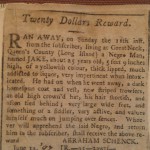Visiting the Brooklyn Historical Society was a complete new experience for me because ive never went to a place where real primary sources were archived throughout the years and be able to use in research. its like a time machine and being able to peer into the past and see some of the past and how it was. it has also changed how i can do research and use primary sources to back up my thesis, or support an argument, or enhance a research paper. it has also changed how i view and read the book beloved and any other piece of literature that is in that time period and about slavery such as the “runaway slave profile” by Franklin/Schwninger it gave some examples and descriptions on how the slave owners put slave ads on newspapers and how they described them,whether they were dark skin, mulatto, etc and any other unique features that could identify the person in the ad. Even though they gave descriptions and how they did it and what the ads looked like it does not compare to actually physically seeing and and reading it for yourself what the ads looked like and what they contained. for example the caricature of a slave next to the ad to signify that it was a slave ad. many different things ive learned and experienced. it has changed how i look at primary sources and where to find them. i hope to return to the BHS in the future and take advantage of the primary sources





